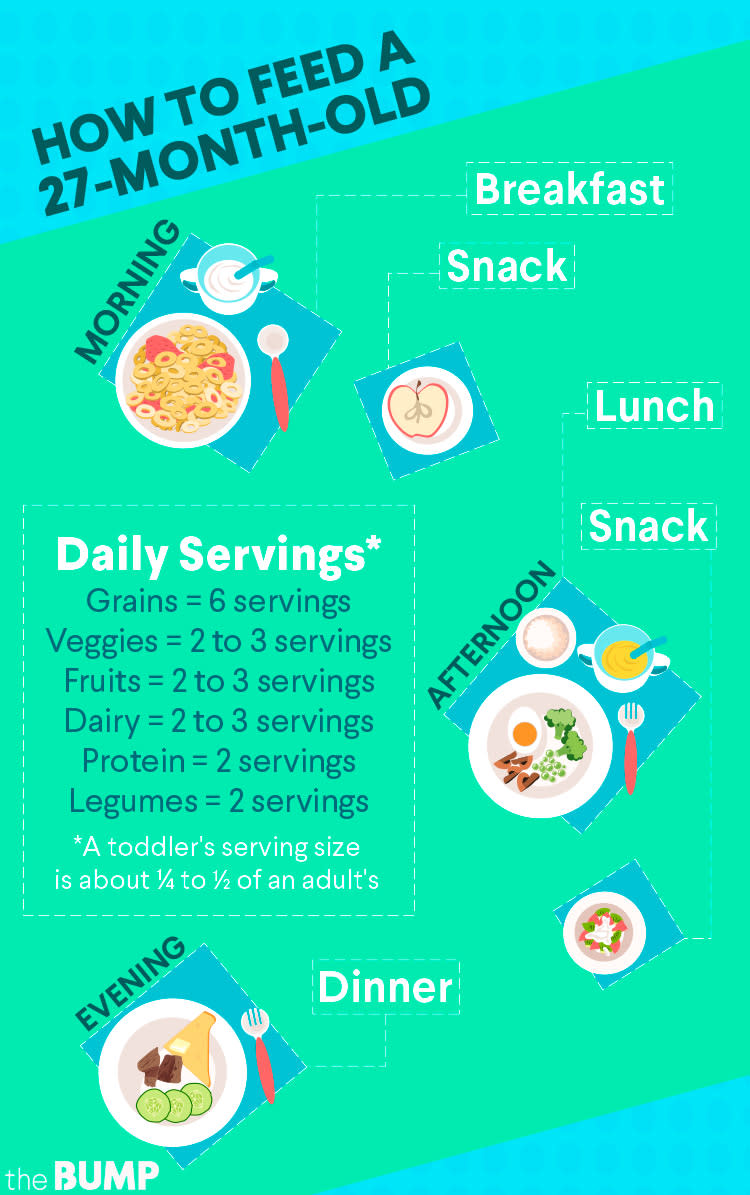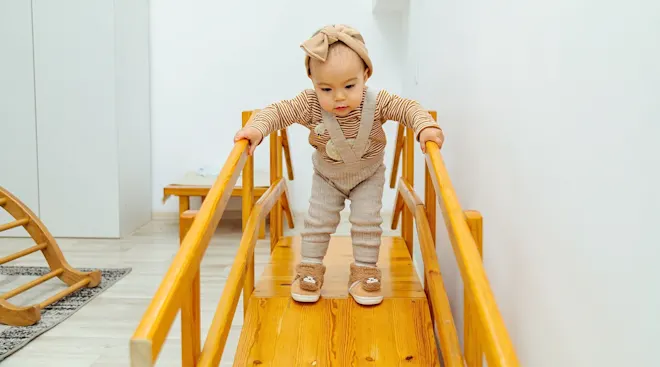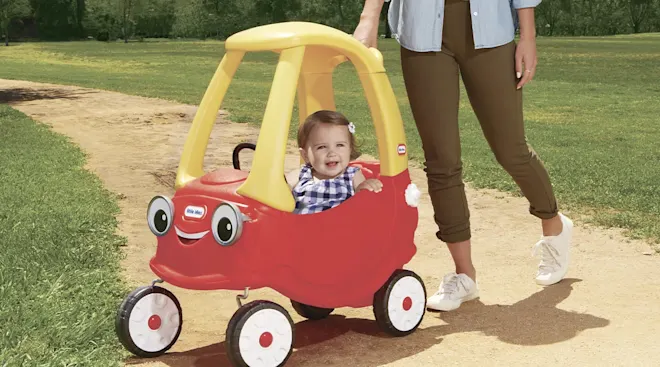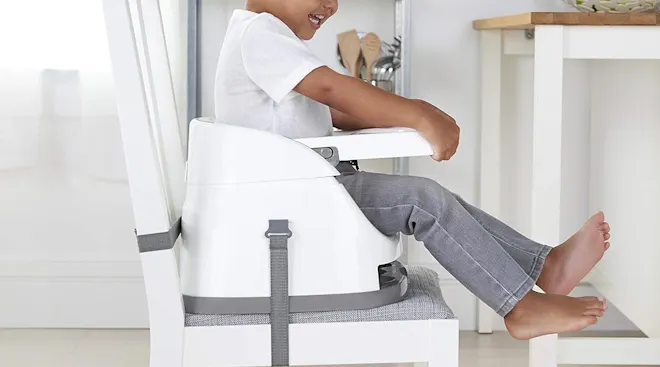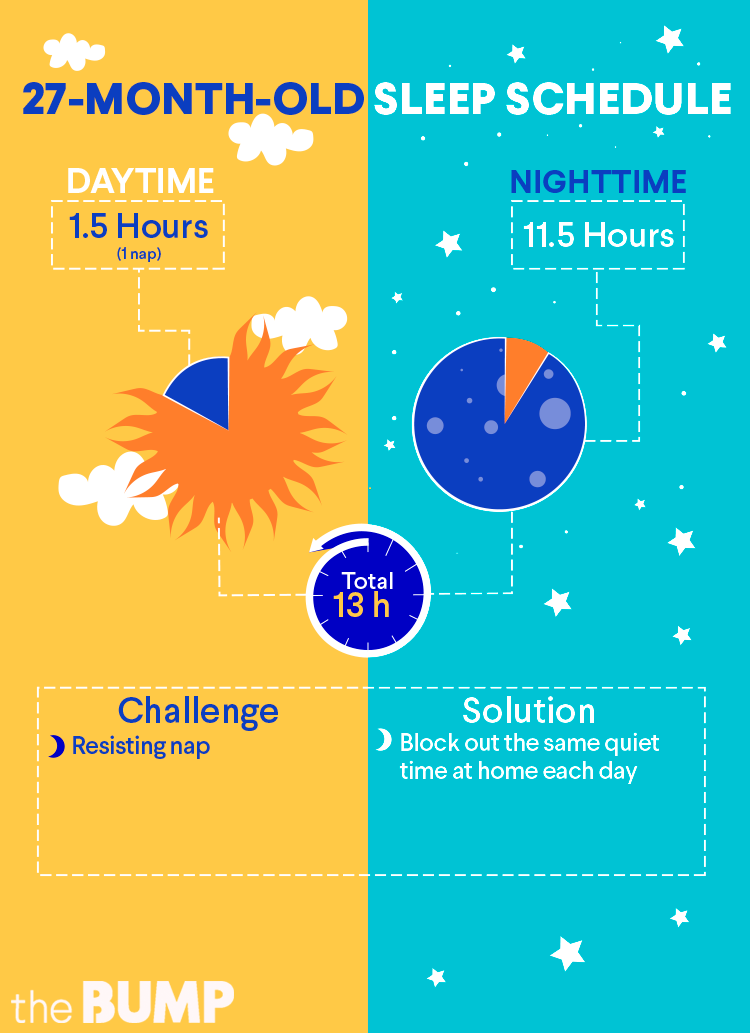Have you noticed your 27-month-old acting differently when they’re outside of your home? Maybe your usually outgoing child hides behind your legs when strangers are around, or maybe they’re an angel at daycare and a troublemaker at home. This inconsistency is completely normal at this age. Two-year-olds adapt their behavior to the environment and the people around them. Unfortunately for you, the fact that your child trusts you means they’re more likely to feel comfortable enough to test your limits and push your buttons.
As your 27-month-old grows, learns new skills and meets new 27-month-old milestones, you'll find them making a ton of changes. They’ll want to practice doing things on their own, but your kiddo also might get frustrated when things don’t go as they planned.
27-month-old weight and height
Average weight for a 27-month-old is around 27.8 pounds for girls and 29 pounds for boys. Average height is around 34.6 inches for girls and 35.1 inches for boys, according to the US Centers for Disease Control and Prevention (CDC). Ask your pediatrician if your 27-month-old’s growth is on track for their growth chart.
27-month-old milestones
At this stage, 27-month-old milestones are all about a growing sense of independence and expanding vocabulary. Here are some milestones your 27-month-old may have hit or may be working on:
- Speech. While your 27-month-old may be saying more words, they might not all be easy to understand. Two-year-olds commonly have trouble properly making certain letter sounds (th, l or s, for example). Stuttering and mixing up the order of words within a sentence are typical too. But these aren't usually considered issues at this age—your child is still learning! A 27-month-old baby who’s not talking, on the other hand, probably needs some extra help. Discuss any speech concerns with your pediatrician.
- Potty training. Haven't started potty training? The time might be now! One study found potty training was most successful with kids when started between 27 and 32 months of age. This is the time frame kids tend to be mature enough to get it, but not old enough to want to resist too much.
- Teething. Your child may be cutting their second molars. Also known as the 2-year molars, these pearly whites tend to erupt between 20 and 33 months. And since they're big, it can be a painful process. The good news is they're the last teeth to come in until around age 6, when kids can better deal with the discomfort, so soon, you'll be done with teething woes.
What should my 27-month-old be doing?
Your 27-month-old should be interested in trying new things and exploring! That can include major 27-month-old milestones like potty training, but it can also include more confident behavior like playing farther away from you at the park. Expect lots of chatter and pretend play from your 27-month-old baby.
What should a 27-month-old be saying?
Speech development varies quite a bit, but your 27-month-old should be saying about 50 words by now, and adding new words each month. Your toddler should also be using two-word sentences like, “more banana” or “go now.” If your child has not yet reached these 27-month-old milestones, check in with your pediatrician to see whether your child should be evaluated for hearing problems or a speech delay.
27-month-old behavior
- Love of repetition. Your 27-month-old does things over and over again—a little scientist at work, they’re trying to see if X always leads to Y. Predictable, repetitive results help them feel secure in the world. So even though you might be sick of reading Goodnight Moon, your toddler is most definitely not. Go ahead and read it again.
- Parallel play. Your child might not play with other kids just yet, but they may enjoy playing alongside other kids doing the same activity. You may notice your 27-month-old copying other kids too.
- Fear of strangers or places. You might find your 27-month-old has a fear of the doctor or barber. This is part of a very normal stage and shows their neurological system, which alerts them to danger, is developing.
Health is always a top concern for parents, and this age is no different. Some common health questions parents of 27-month-olds have are:
- My 27-month-old has diarrhea. What should I do?
- My 27-month-old is constipated. What should I do?
- My 27-month-old is throwing up. What should I do?
- My 27-month old has a cough. What should I do?
- My 27-month-old has a fever. What should I do?
When feeding a 27-month-old, don't focus too much on quantity, and don't sweat it if every meal your toddler eats isn't perfectly balanced. In fact, experts recommend looking at toddler nutrition over the course of a week, not a day, when evaluating whether or not your kid is eating right.
How much should my 27-month-old be eating
Two-year olds should continue to eat three meals per day, plus one or two snacks. Offer your child a variety of foods in all food groups—vegetables, fruits, grains, protein and dairy—daily. Portion size isn't big at this age: Expect your kid to eat only ¼ to ½ as much as an adult.
How much milk should a 27-month-old drink
Your 2-year-old should now be drinking 1 percent or skim milk rather than whole milk. Try to offer other dairy products too, such as yogurt and cheese. Doctors recommend kids ages one to three get 700 mg of calcium per day and 600 IU of vitamin D, which helps aid calcium absorption. Give your 27-month-old baby 16 oz of milk per day, but no more than 24 oz so it doesn’t affect their appetite.
What to feed my 27-month-old
Getting a 27-month-old to eat a balanced diet can be tricky. Looking for some tasty and nutritious meal inspiration? Check out these food ideas for a 2-year-old:
27-month-old feeding schedule
27-month-old eating problems
Some 27-month-olds may seem more interested in snacks than they are in meals. If you can't beat 'em, join 'em! Make sure the snack choices you give your toddler are healthy and well balanced. That way, you'll know that your child is getting good nutrition throughout the day, even if they barely touch their dinner.
Consistency is key for helping a 27-month-old have healthy sleep habits. So stick to a usual bedtime and routine, and continue to set aside time for a daily nap.
How much sleep does a 27-month-old need?
Most 2-year-olds need around 11 to 12 hours of nighttime sleep, plus a nap of about 1.5 to 3 hours, for a total of about 13 to 14 hours of sleep per day.
27-month-old sleep schedule
Every kid is different, but your child's schedule may look something like this:
27-month-old sleep problems
Is your 27-month-old baby resisting naps? Stick to the schedule. Even if your 2-year-old seems like they want to stop napping, they still need up to 14 hours total sleep per day to feel fully rested. And a routine is the best way to make it happen. So make sure you're blocking out the same quiet time each day for a nap at home.
While your 27-month-old plays, they’re learning and developing their cognitive and motor skills. Help your kiddo meet their 27-month-old milestones by giving them plenty of opportunities for enriching, educational-based play. So what to do with a 27-month-old? Some fun activities, games and toys for a 27-month-old include:
- Puzzles and latch boards. Your child will learn about shapes and hone their fine motor skills by assembling and latching wood pieces into place.
- Push-and-pull toys. Toy shopping carts and mini wagons give your toddler a chance to work on gross motor skills.
- Lacing. Wood shapes with holes for laces, or big beads with yarn, are fun projects to keep 27-month-olds busy.
- Try to avoid power struggles with your toddler. There are going to be a lot of things you can't force your child to do (eat, sleep and use the potty, to name a few). Save the discipline for when your child really breaks the rules, such as biting.
- One of the most challenging behaviors reported by parents with a 27-month-old is whining—which can be super-frustrating for you, but it’s usually the result of frustration your child is experiencing. Even highly verbal 2-year-olds don’t have the communication skills to fully express their feelings and desires. Kids can resort to whining especially when they’re tired or hungry. Pay attention to when the whining happens most (is it when your 27-month-old is tired or right before dinner?) so you can try to head it off. When your 27-month-old baby does whines, encourage them to use their “big kid voice” and offer positive reinforcement when your child asks for something politely.
- Work on problem-solving skills with your 27-month-old to help them learn to cope with frustration and find solutions of their own. (This can help the whining too!) If you notice your little one is having difficulty with something, help them work on solving the problem. Example: “I see that you’re trying to carry that broom through the doorway, but it doesn’t seem to fit, does it? Do you think there’s a way to make it fit?”
- Switching to a big bed? Some parents ease the transition by letting a child nap in the bed for a few days before trying it for a whole night.
- Now that your child is getting more independent, find ways to focus on you. Make more plans to get coffee or a meal with friends, join a club or take a class in a topic or hobby that interests you.
Please note: The Bump and the materials and information it contains are not intended to, and do not constitute, medical or other health advice or diagnosis and should not be used as such. You should always consult with a qualified physician or health professional about your specific circumstances.
Navigate forward to interact with the calendar and select a date. Press the question mark key to get the keyboard shortcuts for changing dates.


































